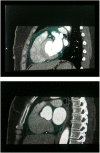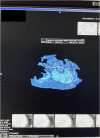Pericardial fat volume and coronary atherosclerotic markers among body mass index groups
- PMID: 32492245
- PMCID: PMC7462198
- DOI: 10.1002/clc.23396
Pericardial fat volume and coronary atherosclerotic markers among body mass index groups
Abstract
Background: Increased pericardial fat volume (PFV) is associated with coronary atherosclerosis burden independent of body mass index (BMI) in many clinical studies. However, the association of PFV with markers of coronary atherosclerosis has not yet been assessed by dividing the patients according to BMI categories.
Hypothesis: To assess the association of PFV measured by multi-detector CT (MDCT) angiography with coronary atherosclerotic markers (coronary artery calcium score [CAC], plaque type, and luminal stenosis) among BMI categories.
Methods: A total of 496 patients with suspected coronary artery disease who underwent 64-slice MDCT angiography examination were enrolled. Patients divided into obese, overweight, and normal weight groups according to BMI degree.
Results: PFV showed a significant association with CAC, non-calcified coronary plaque, and significant coronary stenosis in obese group. After adjusting for cardiac risk factors, the association of PFV with the non-calcified coronary plaque and significant coronary stenosis persisted. There was a significant association between PFV with CAC and significant coronary stenosis in normal weight group. The association between PFV with CAC and significant coronary stenosis in normal weight was persisted afar adjusting for cardiac risk factors. No significant association was noted between PFV with coronary plaque type in normal weight group. There was no significant independent association between PFV with coronary atherosclerotic markers in overweight group.
Conclusions: Increased PFV was associated with advanced stage atherosclerosis in normal weight group, while increased PFV was associated with non-calcified plaque in obese. These results highlight the differential relationship of PFV with coronary atherosclerotic markers among BMI categories.
Keywords: BMI; CT angiography; coronary atherosclerosis; obesity; pericardial fat.
© 2020 The Authors. Clinical Cardiology published by Wiley Periodicals, Inc.
Conflict of interest statement
The authors declare that they have no conflict of interest.
Figures
References
-
- Ferrara D, Montecucco F, Dallegri F, Carbone F. Impact of different ectopic fat depots on cardiovascular and metabolic diseases. J Cell Physiol. 2019;234(12):21630‐21641. - PubMed
-
- Antonopoulos AS, Tousoulis D. The molecular mechanisms of obesity paradox. Cardiovasc Res. 2017;113(9):1074‐1086. - PubMed
-
- Lee HY, Després JP, Koh KK. Perivascular adipose tissue in the pathogenesis of cardiovascular disease. Atherosclerosis. 2013;230(2):177‐184. - PubMed
MeSH terms
LinkOut - more resources
Full Text Sources
Medical



